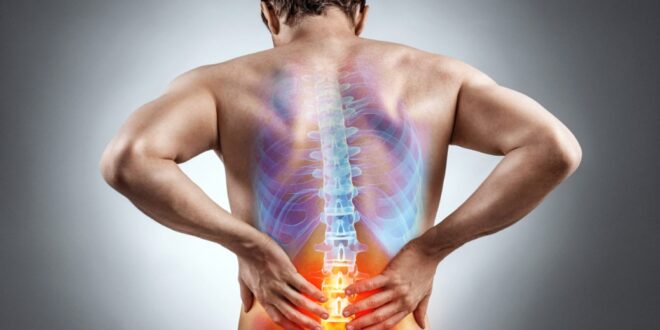Our spine is an incredibly important part of the human body, providing support, flexibility, and protection to the delicate spinal cord. But what happens when it gets out of alignment?
In this article, we’ll dive deep into the causes and symptoms of a misaligned spine, shedding light on why this condition occurs and how it can impact your overall well-being.
Get ready to discover the hidden secrets of a healthy spine!
What Is a Misaligned Spine?
Before we dive into the causes and symptoms, let’s first understand what a misaligned spine is. You see, the spine, or backbone is made up of vertebrae that stack on top of each other, forming the spinal column.
Ideally, these vertebrae should align perfectly to keep our spine straight and balanced. But sometimes, various factors can mess with this alignment, leading to what we commonly call a misaligned spine.
We’re talking about when the vertebrae aren’t in their proper position. This misalignment can affect the entire spine or specific regions like the neck, upper back, or lower back. It’s important to grasp the causes and recognize the symptoms of a misaligned spine so we can seek timely help and prevent further complications.
Causes of a Misaligned Spine

A misaligned spine, also known as spinal misalignment or vertebral subluxation, can result from various factors. Here are some common causes:
Poor Posture
Poor posture is one of the main culprits behind a misaligned spine. You see, with our sedentary lifestyles and all those hours we spend sitting, we unknowingly put our spine under a lot of stress. So, when we slouch or maintain improper posture for long periods, it slowly shifts our vertebrae out of alignment, causing that spine situation.
Trauma and Injuries
Car accidents can be traumatic, causing severe misalignments in the spine. The impact from the collision can jolt your spine out of its normal position, leading to all sorts of issues.
Whiplash, a common injury in these accidents, happens when your head is forcefully jerked backward and then forward, putting a strain on your neck and spine. So, it’s super important to seek medical attention right away and get the right treatment to address any potential spine misalignments and prevent long-term problems.
Muscular Imbalances
Muscle imbalances can have a pretty big impact on spinal misalignment. When certain muscle groups are stronger or more dominant than others, they can pull the spine out of its natural alignment. This imbalance can happen if you’re not getting enough exercise, doing workouts the wrong way, or favoring one side of your body too much.
But don’t worry! By strengthening your core muscles and working on overall muscular balance through targeted exercises, you can help prevent and fix those pesky spinal misalignments.
Degenerative Conditions
Degenerative conditions like osteoarthritis and degenerative disc disease can cause the spine’s structures to gradually break down. As a result, the vertebrae may shift, causing misalignment. Managing these conditions is crucial to prevent spinal misalignment from getting worse.
Aging
As we age, the spine undergoes natural wear and tear, which can contribute to misalignments. Disc degeneration, loss of bone density, and changes in the spinal joints can affect the overall alignment of the spine.
While aging is inevitable, maintaining a healthy lifestyle, including regular exercise and proper nutrition, can slow down the degenerative process and promote spinal health.
Symptoms of a Misaligned Spine

Recognizing the symptoms of a misaligned spine is vital for early intervention and preventing the development of more severe issues. While the symptoms can vary depending on the location and severity of the misalignment, common signs include:
Back Pain
Experiencing persistent back pain? It’s a common symptom of a misaligned spine. You might feel the pain in a specific area or it might radiate along your spine, affecting your mobility and daily activities.
Limited Range of Motion
When your spine is misaligned, it can cause stiffness and reduce your flexibility. You might find it hard to bend, twist, or turn, which can limit your range of motion.
Headaches
Misalignments in the cervical spine can contribute to tension headaches and migraines. The tension in the neck and upper back can radiate up to your head. This causes those pesky chronic headaches.
Nerve Compression
Spinal misalignment can lead to nerve compression. This can cause symptoms like tingling, numbness, or weakness in your arms or legs. This happens when the displaced vertebrae put pressure on the nerves branching out from your spinal cord.
Postural Changes
If you notice any changes in your posture like one shoulder being higher than the other or a tilted pelvis, it could be a sign of a misaligned spine. These changes in posture can put extra strain on your spine and the muscles around it.
Seeking Professional Help for a Misaligned Spine

If you suspect a misaligned spine, consult a healthcare professional. A thorough examination can diagnose the extent and location of the misalignment. It includes imaging studies like X-rays or MRI scans. Treatments are available to address it.
Chiropractic Care
Chiropractic adjustments, performed by licensed chiropractors, offer a non-invasive and drug-free treatment after a car accident. By applying controlled force to specific joints, these adjustments aim to:
- realign the spine
- restore proper alignment
- alleviate pain
- enhance spinal function
Physical Therapy
Physical therapy focuses on strengthening and stretching exercises. The goal is to address muscle imbalances and improve spine stability. They can create a personalized exercise program to target specific misalignments. This can improve your spinal health.
Lifestyle Modifications
We can prevent and ease spinal misalignment by working on our posture, keeping a healthy weight, and staying active. Making small changes, such as using ergonomic furniture, can make a big difference. Taking breaks when sitting for extended periods can also help.
Medications
Sometimes, doctors may prescribe medications to help with pain and inflammation caused by a misaligned spine. But it’s important to remember that medications are just one part of a comprehensive treatment plan, not a standalone solution.
Prioritizing Spinal Health
Understanding the causes and symptoms of a misaligned spine is crucial for spinal health. Factors like poor posture, trauma, and degenerative conditions contribute to misalignment. Timely intervention after a car accident can prevent complications.
To prioritize spinal health, maintain good posture, stay active, and seek professional care when necessary. These steps promote a well-aligned spine, reducing discomfort and health issues. A healthy spine contributes to overall well-being, enabling a fulfilling life.
If you would like to read more articles like this, check out the rest of our website.
 Hi Boox Popular Magazine 2024
Hi Boox Popular Magazine 2024



